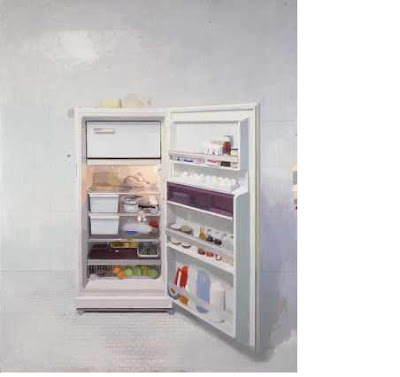Recently I have visited an exhibition of one of my favourite contemporary Spanish painters at the Museo Thyssen-Bornemisza and since I enjoyed so much the visit I thought I could write a post about him and share it here.
Antonio Lopez Garcia was born on January 6th, 1936 in Tomelloso (Ciudad Real) a few months before the beginning of the Spanish Civil War. It first appeared that Antonio would continue in the family tradition as a farmer but thanks to his uncle Antonio Lopez Torres, a local painter of landscapes, who gave him his first lessons, he moved to Madrid in 1949 in order to study for entrance to the Real Academia de Bellas Artes de San Fernando.
Between 1950 and 1955 he studied art there, winning some awards. While at the school he developed a friendship with Maria Moreno, also a painter, whom he would marry in 1961. Madrid of the postwar period was isolated from the international panorama of art and cultura and all the information he could get was derived from library books at the school.
In 1955, after winning the III National Art Contest in his final year of art school, he was awarded a trip to Italy by the Spanish Ministry of Education, in order to study the works of Renaissance masters. During this period he began to reevaluate Spanish painting in the Prado, especially Velazquez, a constant reference in his painting.
In 1957 his work had registered a certain surreal quality, remaining his fantastic vein at least until 1964. Through the mid-1960s, as he said, “the physical world gained more prestige in my eyes”. There are many affinities with the Tuscan Renaissance in his work in three dimensions. He depicts humble people, buildings, desolated spaces, images of his garden and landscape and humbled objects of domestic surroundings and the city of Madrid is a constant theme in his work, in his cityscapes he emphasizes the anonymity of the contemporary cities. Usually he works in his paintings for more than twenty years, even some of them remaining unfinished.
He is a versatile realist and it is possible to establish links between his work and the new European figurative tendencies of the American hyperrealism. According to his techniques, he is proficient in the traditional media of pencil drawing, oil painting on board, carved wood sculpture and bas relief in plaster. In fact his works shows in three media (painting, drawing and sculpturing).
He is not very prolific, so he has only had a handful of one-artist shows. In 1961 he had his first solo show in Madrid and later, in 1965 and 1968, at the Staempfli Galery in New York. His last retrospective exhibition took place in 1993 and in these two last decades he has produced some of his masterpieces. And currently he is having a temporary exhibit at the Thyssen Museum in Madrid, which will finish on 25th September.
In recent years Lopez was inducted as an honorary member of the Academy of Arts and Letter in New York (2004) and in 2006 he was awarded the Velazquez Prize for Fine Arts.
Recently you could see him painting at Puerta del Sol Square in Madrid on a new work, regardless of the curious stares of people who stopped to look at him. Then, after sunset he picked up his easel and other stuff and, leaving to go home. He did this every day for several days.
And here you are some more of his works:


















































